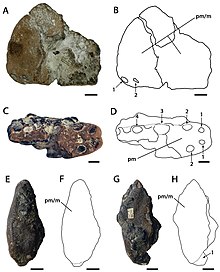| Ornithocheirus Temporal range: Early Cretaceous,
| |
|---|---|

| |
| Holotype of O. simus, CAMSM B54428, and referred specimen CAMSM B54552 (holotype of the junior synonym O. platyrhinus) | |
| Scientific classification | |
| Domain: | Eukaryota |
| Kingdom: | Animalia |
| Phylum: | Chordata |
| Order: | †Pterosauria |
| Suborder: | †Pterodactyloidea |
| Family: | †Ornithocheiridae |
| Subfamily: | †Ornithocheirinae Seeley, 1870 |
| Genus: | †Ornithocheirus Seeley, 1869 |
| Type species | |
| †Ornithocheirus simus Owen, 1861
| |
| Species | |
| |
| Synonyms | |
| |
Ornithocheirus (from Ancient Greek "ὄρνις", meaning bird, and "χεῖρ", meaning hand) is a pterosaur genus known from fragmentary fossil remains uncovered from sediments in the United Kingdom and possibly Morocco.[1]
Several species have been referred to the genus, most of which are now considered as dubious species, or members of different genera, and the genus is now often considered to include only the type species, Ornithocheirus simus. Species have been referred to Ornithocheirus from the mid-Cretaceous period of North America, Europe and South America, but O. simus is known mostly from the United Kingdom, though a specimen referred to O. cf. simus is also known from Morocco.
Because O. simus was originally named based on poorly preserved fossil material, the genus Ornithocheirus has suffered enduring problems of zoological nomenclature.
Fossil remains of Ornithocheirus have been recovered mainly from the Cambridge Greensand of England, dating to the beginning of the Albian stage of the early Cretaceous period, about 110 million years ago.[2] Additional fossils from the Santana Formation of Brazil are sometimes classified as species of Ornithocheirus, but have also been placed in their own genera, most notably Tropeognathus.[3][4]
- ^ Megan L. Jacobs; David M. Martill; David M. Unwin; Nizar Ibrahim; Samir Zouhri; Nicholas R. Longrich (2020). "New toothed pterosaurs (Pterosauria: Ornithocheiridae) from the middle Cretaceous Kem Kem beds of Morocco and implications for pterosaur palaeobiogeography and diversity". Cretaceous Research. 110: Article 104413. doi:10.1016/j.cretres.2020.104413. S2CID 214542129.
- ^ Vullo, R.; Neraudeau, D. (2009). "Pterosaur Remains from the Cenomanian (Late Cretaceous) Paralic Deposits of Charentes, Western France". Journal of Vertebrate Paleontology. 29 (1): 277–282. doi:10.1080/02724634.2009.10010380. S2CID 197536660.
- ^ Cite error: The named reference
kellneretal2013was invoked but never defined (see the help page). - ^ Unwin, David M. (2006). The Pterosaurs: From Deep Time. New York: Pi Press. p. 246. ISBN 0-13-146308-X.